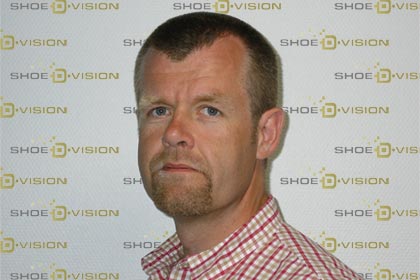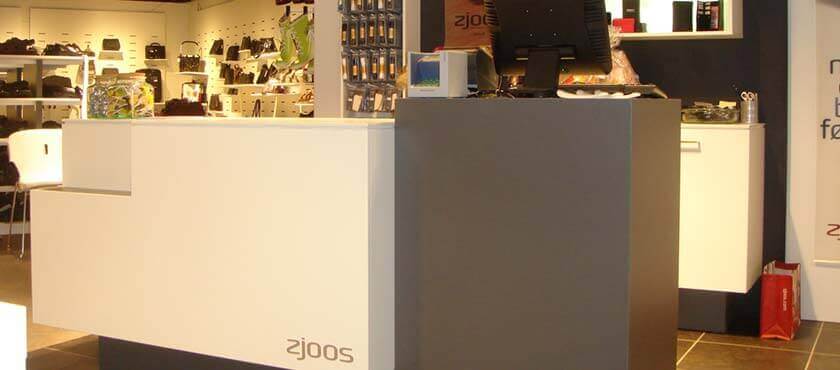Shoe-D-Vision runs faster with LANSA for the Web
Shoe-D-Vision, with its head office in Århus, Denmark, is a co-operative of the Skoringen, Feet Me and zjoos shoe retailers, with nearly 300 stores in Denmark and Norway. A LANSA customer since 1992, Shoe-D-Vision used LANSA to build a retail back office PC system called SHOEit for stores and a central iSeries-based ERP system. Recently Shoe-D-Vision implemented SHOEweb to give stores online access to the ERP system using LANSA for the Web.
Asger Simonsen, IT manager at Shoe-D-Vision says, “Shopkeepers don’t have to re-enter any information since SHOEit integrates with our central ERP system and each shop’s POS system. Now, with SHOEweb, shopkeepers can see which shoes and what sizes we have in stock, then place orders directly in our ERP system. And they can do this at a time that suits them.”
Shopkeepers don’t have to re-enter any information since SHOEit integrates with our central ERP system and each shop’s POS system.
- 270,000 Outgoing Invoices a Year
- SHOEit Back Office Retail System
- SHOEweb Online Access for Shops
- Growing with LANSA Since 1992
- Shoe-D-Vision implements wireless access for shoe shops
(2008 updated) - Company and System Information
270,000 Outgoing Invoices a Year

The shopkeepers in the cooperative jointly own Shoe-D-Vision, which offers IT, marketing and logistics services. Shoe-D-Vision uses its buying power to purchase shoes from manufacturers in Italy, Portugal, Taiwan and Hong Kong. Typically, the company places two very large seasonal orders per year with these manufacturers and smaller orders in between seasons. The stores can also buy their own shoes, so while 70 percent of a shop’s inventory is identical to other shops in the chain, they create their own style and image with the remaining 30 percent.
“We started to use LANSA in 1992 when we moved from the IBM S/36 to the AS/400,” says Simonsen. “Our major reason for selecting LANSA was its productivity and cross platform capabilities. We wanted to deliver local PC-based solutions for the shops as well as a central iSeries-based ERP system with our own small development team. In fact, I was the only developer at that time.”
“In the first year, I built our core ERP system with LANSA for iSeries. The year after that I used Visual LANSA’s predecessor (LANSA PC/X for OS/2), to build a PC-based retail back office system, called SHOEit, which we rolled out to the shops in 1993. Since then, both systems have been continuously upgraded and enhanced.”
“Although many of the transactions between each shop’s back office system and our core ERP system were automated, shops still used to email, fax or phone stock inquiries and manual orders. Not only was this expensive, it was also inconvenient for the shops as our customer services center was only open during normal office hours.”
“While shops must carry a certain range of shoes that we promote via TV commercials and other marketing programs, they also have the option of buying shoes and other related products from Shoe-D-Vision’s own stock. We really needed to provide 24*7 online ordering service to the shops.”
“Whether the stores buy from the cooperative or other vendors, ordering, invoicing and delivery is always via SHOEerp. In 2004, we had 270,000 outgoing invoices that we had to post along with other financial reports and statements. We also used to post a photocopy of the vendor’s original invoice to each shop. This was very labor intensive and postage was expensive, we had to find a better solution.”
“So in 2004, we gave the stores online access to the ERP system using LANSA for the Web and also automated ordering of shoes for upcoming promotions. While we now have three developers, including myself, it is still a small team compared with our industry peers,” says Simonsen.
In 2004, we gave the stores online access to the ERP system using LANSA for the Web and also automated ordering of shoes for upcoming promotions.
SHOEit Back Office Retail System
As each shop-owner may own a number of shops, SHOEit is installed at more than 80 main group offices and manages the inventory for up to 17 shops in each group. The group’s main office can create stock transfers between shops and set up rules for automated stock transfer within the group. The SHOEerp system tracks total group inventory, but takes orders from and delivers to the individual shops.
When each shop closes its POS system, it sends sales, order and stock movement information back to SHOEit, which updates group inventory and generates orders for the group. Overnight SHOEit sends files back to each shop and the local POS databases are updated with order confirmations, delivery notes, product updates, including new item numbers, pictures and prices, plus client and other information. All communication between the shops is done by email over a permanent broadband Internet connection with strict security procedures including file encryption and IP address authentication.
Each night SHOEit also sends summarized sales information into the Shoe-D-Vision ERP system, SHOEerp.
“For shoes that are part of the next season’s promotion, Shoe-D-Vision now automatically creates an order for confirmation in SHOEit. SHOEerp sends electronic delivery notes for confirmed orders and the shop indicates any deviations in their SHOEit system.”
“The shop keepers don’t have to re-enter any information,” says Simonsen.
Claus Lernø, a shopkeeper with three shops in the Skoringen chain, says, “SHOEit is designed to meet all our business needs – from POS, stock management to sales statistics. We don’t have to reenter any information, because all relevant information is exchanged with the central Shoe-D-Vision system.”
“All the boring stuff is removed and we can concentrate on buying the right shoes and can move the shoes around to the shops that are selling them. SHOEit makes the job easy.”
SHOEit is designed to meet all our business needs – from POS, stock management to sales statistics.

SHOEweb Online Access for Shops
For real-time inquiry and ordering, Shoe-D-Vision now also offers web access to its system. The web system, called SHOEweb, was developed with the help of Futura Data, a LANSA Business Partner in Denmark.
“Now shops can see which shoes and what sizes we have in stock and place orders directly in our ERP system, at any time they want. We get far fewer phone calls, email and faxes. Each week we receive an average of 200 orders via the web,” say Simonsen.
“Now that shops have online access to their invoices and outstanding balances, we have stopped mailing invoices and other financial reports and statements,” says Simonsen. “We also stopped sending photocopies of vendor invoices, they are now scanned and available online in SHOEweb.”
“Making invoices available online gave a ROI in under four months. Not mailing 270,000 invoices a year saves a huge amount in stamps and 1½ full time staff in labor.”
“The cycle of invoicing and payments is also faster, especially in Norway where mail used to take three or more days to arrive. Now invoices are available to the shops seconds after we generate them in our system.”
“With the website it is also easy to survey interest in volume-based vendor offers. The shops make conditional orders that are not processed until we place our central order with the vendor. With the paper-based system, we had to wait for a week or more to collect responses and then key them in manually. Now we can make a decision on special vendor offers within a day. And shops can instantly see the status of these offers.”
“The web solution saves the shops and the purchasing department a lot of time,” says Lisbeth Malfeld, purchasing and logistics manager Shoe-D-Vision.
“Before SHOEweb, the purchase department had to produce descriptions of new shoes then wait for a week or more till all shops responded by phone, fax or mail. After that all the orders where keyed in manually.”
“Now it’s all done through SHOEweb and saves us more than 15 hours per week. And the shops put their orders in at a time that suits them best. It’s a real win-win situation. I’m looking forward to getting more business processes on the web,” says Malfield.
Lernø, agrees, “I am no longer limited by Shoe-D-Vision office hours and have more freedom to work when I have the time. With SHOEweb, I can order shoes for immediate delivery since I know exactly what sizes are in stock at the time I order them.”
“Our internal people also have browser access to the ERP system, but at a different level, with higher authority,” says Simonsen. “Because it is now so easy to look at the data, the friendly web interface often avoids the need for printed ERP reports.”
Making invoices available online gave a Return on Investment in three to four months.
Growing with LANSA Since 1992
“LANSA has evolved enormously over the thirteen years we have been using it and let us evolve our systems as well,” says Simonsen.
“The new LANSA IDE look great and adds even more to our productivity. It gives a much better view of available components, code and resulting functions in a single view.”
“We are very proud of the efficient business systems we have achieved with LANSA. The shops pay us to make sure we have the right systems and tools to provide a competitive advantage. We certainly have been able to do that and on a very modest budget.”
“LANSA is very productive. In other development environments, you have to take care of so many things yourself. There is so much low-level plumbing work you have to do to get things working. For example, database handling is much easier in LANSA than it is in Visual Basic.”
“We are a small team of three developers, including myself, plus three network support. LANSA lets us deliver and maintain a Windows system for the shops, an iSeries-based ERP system and a dynamic web solution, all with a single tool set,” concludes Simonsen.
LANSA has evolved enormously over thirteen years. The new LANSA IDE look great and adds even more to our productivity.
Shoe-D-Vision implements wireless access for shoe shops (2008 updated)
Shoe-D-Vision has implemented wireless access via handheld PDAs for shop employees so they can easily access information, such as stock on hand, register sales and shoes on sale, for all the shops in their group. “LANSA remains a strategic choice for Shoe-D-Vision to ensure we give our members a competitive advantage,” adds Simonsen.
Company and System Information
- Shoe-D-Vision has its head office in Denmark, north of Aarhus, where und 45 employees take care of the purchasing, logistics, marketing, training, store design, merchandising as well as retail IT and operating advice for nearly 300 shops. Through its chains Skoringen, zjoos and Feet Me, Shoe-D-Vision supplies Danish and Norwegian consumers with some 3.6 million pairs of shoes a year.
- For more information visit: https://s-d-v.dk/
- SHOEit was developed with Visual LANSA and integrates with the Visual Basic-based POS systems, called SHOEshop, installed in each individual shop and with the central LANSA for iSeries ERP system. Most SHOEit sites run on Windows 2000, and connect with two or three individual shoe shop POS systems. Shoe-D-Vision uses an IBM iSeries 270 for operations, web serving and development.
- Other solutions at Shoe-D-Vision that integrate with the LANSA-built systems include SAS Windows data warehouse software to analyze summarized information extracted from the ERP system, Alligator Financial System on the iSeries and Interform, from SpaceTec, to convert iSeries spool files to PDF.
![]()
- Futura Data A/S is a LANSA business partner in Denmark. For more information visit: www.futura-data.dk

